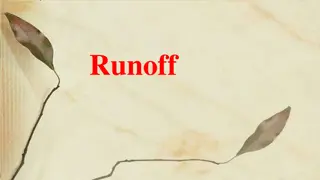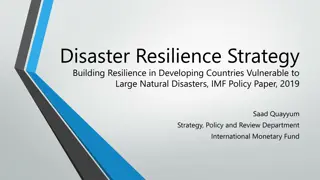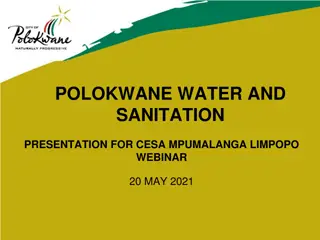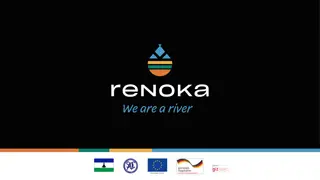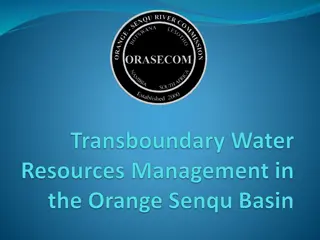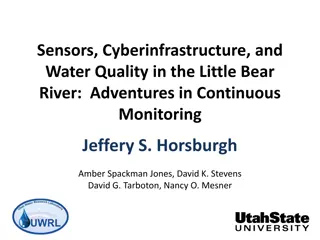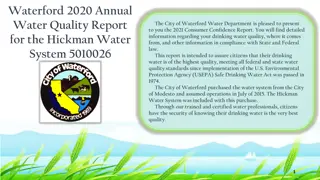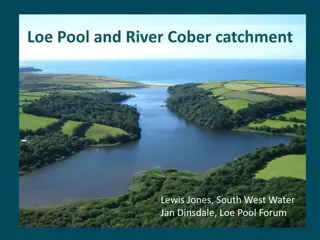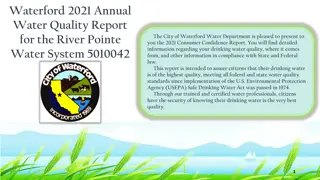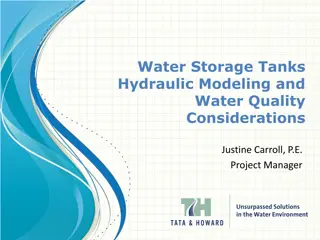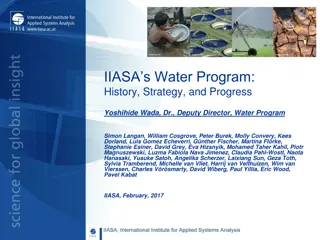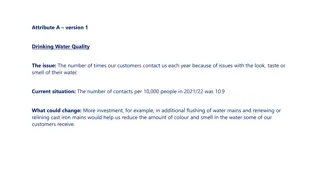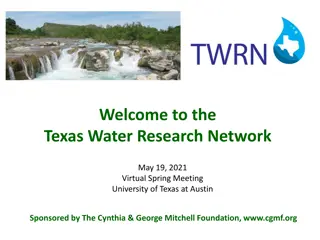Enhancing Water Quality through Catchment Resilience
Safeguarding and improving raw water quality by increasing catchment resilience is crucial in the face of mounting pressures on water resources. This involves understanding catchment conditions, anticipating future changes, and implementing mitigation measures. The project aims to explore the benefits of such actions for both the economy and society, as presented at the Scottish Water Catchment Conference.
Download Presentation

Please find below an Image/Link to download the presentation.
The content on the website is provided AS IS for your information and personal use only. It may not be sold, licensed, or shared on other websites without obtaining consent from the author.If you encounter any issues during the download, it is possible that the publisher has removed the file from their server.
You are allowed to download the files provided on this website for personal or commercial use, subject to the condition that they are used lawfully. All files are the property of their respective owners.
The content on the website is provided AS IS for your information and personal use only. It may not be sold, licensed, or shared on other websites without obtaining consent from the author.
E N D
Presentation Transcript
Safeguarding and improving raw water quality by increasing catchment resilience Carolin Vorstius1, John Rowan1, Iain Brown1, Zoe Frogbrook2, Javier Palarea-Albaladejo3 1School of Social Sciences, University of Dundee, 2Scottish Water, 3Biomatehematics and Statistics Scotland Scottish Water Catchment Conference, 06/09/2018
Context Drinking water: An essential commodity Multiple and mounting pressures on our water resources Climate and land use changes: Insecurity of stable supply of high quality drinking water Rising treatment costs Need to target mitigation measures Strategic long-term investments into treatment Carolin Vorstius Scottish Water Catchment Conference, 06/09/2018
Key questions 1) What do the catchments that we use as drinking water resources in Scotland look like and what conditions and pressures act on their water quality? 2) How are catchments likely to change in future and what does this mean for the water quality they yield? 3) Where can catchment-based mitigation measures help to improve and safeguard water quality? 4) What are the economical an societal advantages of implementing such measures? Carolin Vorstius Scottish Water Catchment Conference, 06/09/2018
How? - Project steps 1) What do the catchments that we use as drinking water resources in Scotland look like and what conditions and pressures act on their water quality? Carolin Vorstius Scottish Water Catchment Conference, 06/09/2018
How? - Project steps 2) How are catchments likely to change in future and what does this mean for the water quality they yield? Carolin Vorstius Scottish Water Catchment Conference, 06/09/2018
How? - Project steps 3) Where can catchment-based mitigation measures help to improve and safeguard water quality? Carolin Vorstius Scottish Water Catchment Conference, 06/09/2018
How? - Project steps 4) What are the economical an societal advantages of implementing such measures? Ecosystem Services Assessment Carolin Vorstius Scottish Water Catchment Conference, 06/09/2018
Projected outcomes 1) Risk assessment: Identification of catchments at risk of deteriorating water quality Identification of contributing factors Estimate of possible/probable effects of mitigation measures 2) Ecosystem Services Assessment: Identification of benefits and trade- offs of managing for water quality Carolin Vorstius Scottish Water Catchment Conference, 06/09/2018
Catchment characterisation 398 active catchments (141 rivers, 49 lochs, 146 impounding reservoirs, 21 springs, 41 boreholes) Distribution of slopes Histogram of catchment area in km2 Carolin Vorstius Scottish Water Catchment Conference, 06/09/2018
Catchment characterisation Carolin Vorstius Scottish Water Catchment Conference, 06/09/2018
Catchment characterisation Carolin Vorstius Scottish Water Catchment Conference, 06/09/2018
Water quality Catchment medians Iron Aluminium Colour E. coli pH Turbidity Carolin Vorstius Scottish Water Catchment Conference, 06/09/2018
Water quality Catchment medians 5th 25th 75th 95th Minimum Median Mean Maximum Consumer s tab Aluminium ( g Al/l) 9 24.65 42.25 64.75 76.26 92.88 168.45 404 200 Colour (mg/l Pt/Co) 2 11 24 33.75 38.95 49.62 81 167.5 20 Iron ( g Fe/l) 7 44.95 108.1 179.5 267.4 361.8 783.4 1465 200 Manganese ( g Mn/l) 1 2 5.5 13 22.12 27 60.39 405.5 50 pH 5.5 6.2 0.3 6.7 0.45 7.1 0.6 7.06 1.03 7.4 1 7.7 4 8.4 6.1 6.5-9.5 4 Turbidity (NTU)0.2 Coliforms (CFU in 100ml) 9 28.65 88 190 279.2 285 552 4950 0 E. coli (CFU in 100ml) 0 0 1 4.25 17.62 10 40.17 580 0 Carolin Vorstius Scottish Water Catchment Conference, 06/09/2018
Water quality Time series Carolin Vorstius Scottish Water Catchment Conference, 06/09/2018
Typology and models Data analysis issues Key issues in the data analysis: Different sample sizes Very skewed distributions within catchments as well as catchment medians Data for some catchments show seasonal patterns Very high outliers Of interest are middle points of the data as well as extremes Analysis performed: Principal Component Analysis Cluster Analysis Multi-target regression trees Carolin Vorstius Scottish Water Catchment Conference, 06/09/2018
Typology and models PCA Carolin Vorstius Scottish Water Catchment Conference, 06/09/2018
Data analysis Cluster Analysis Carolin Vorstius Scottish Water Catchment Conference, 06/09/2018
Data analysis Regression trees E. coli medians and 95th percentiles Colour medians and 95th percentiles PrecdaysAnnual > 1.77 +--yes: Arable15 > 0.05 | +--yes: SlopeLittle > 18.57 | | +--yes: [16.12, 169.54]: 8 | | +--no: [77.25, 1700.5]: 2 | +--no: Imprgrass15 > 28.01 | +--yes: [15, 418.25]: 2 | +--no: ReliefRatio > 0.129 | +--yes: Source = 'Loch' | | +--yes: [10, 586.32]: 2 | | +--no: [7.83, 111.14]: 21 | +--no: [5.50, 72.67]: 69 +--no: [292.5, 2064.37]: 4 SlopeSteep > 20.18 +--yes: SlopeSteep > 36.5 | +--yes: [16.23, 37.12]: 13 | +--no: [29.11, 57.51]: 22 +--no: Peat > 81.69 +--yes: [58.8, 130.65]: 28 +--no: [37.75, 74.47]: 45 RMSE: [24.3, 48.12] R2: [0.48, 0.42] RMSE: [55.46, 660.57] R2: [-0.03, -0.04] Carolin Vorstius Scottish Water Catchment Conference, 06/09/2018
Typology and models Further approach Lead areas identified from data analysis: DOC release from peatland contributing conditions and climate change Expansion of areas suitable for (more intensive) agriculture through climate change Next steps: Analyse a subset of catchment with high peatland cover with regard to catchment conditions and colour concentrations Analyse a subset of catchments with regard to relationships between certain types of land use (arable agriculture and improved grassland) and E. coli contamination Carolin Vorstius Scottish Water Catchment Conference, 06/09/2018
Safeguarding and improving raw water quality by increasing catchment resilience Thank you! a.c.vorstius@dundee.ac.uk And thank you to Scottish Water for providing the data The Scottish Government (Hydro Nation Scholars Programme) for funding this research Carolin Vorstius Scottish Water Catchment Conference, 06/09/2018
Data analysis PCA PC1 Loadings 0.39* PC2 PC3 Water quality Aluminium Median Colour Median 0.39* Iron Median Manganese Median pH Median Turbidity Median -0.09 -0.33* -0.08 -0.09 0.46* 0.08 -0.12 -0.09 -0.02 0.33* 0.66* 0.33* 0.48* 0.42* -0.09* 0.43* Coliform Median 0.18* E.coli Median Catchment characteristics Deciduous woodland Arable Improved grassland Urban Relief ratio Little slope Steep slope Sandstone Mean monthly total rainfall Mean number of days per months with >10mm precipitation Carolin Vorstius Scottish Water Catchment Conference, 06/09/2018 0.50* 0.63* -0.57* -0.09 0.24* Correlations 0.16 0.42 0.29 0.39 0.25 -0.31 0.26 -0.23 Variability explained: PC1: 46% PC2: 20% PC3: 14% Total: 80% 0.20 -0.22 -0.19 -0.17 -0.21
Data analysis Cluster Analysis Carolin Vorstius Scottish Water Catchment Conference, 06/09/2018
Data analysis Cluster Analysis Carolin Vorstius Scottish Water Catchment Conference, 06/09/2018
Data analysis Cluster Analysis Carolin Vorstius Scottish Water Catchment Conference, 06/09/2018






